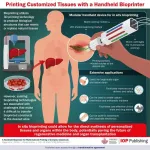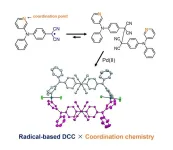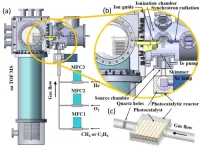(Press-News.org) Tulsa, Okla. – A pioneering study conducted by researchers at the Laureate Institute for Brain Research (LIBR) in Tulsa, Okla., has made significant strides in understanding the elusive gut-brain connection, a complex relationship that has long puzzled scientists due to the difficulty of accessing the body's interior. The study, “Parieto-occipital ERP indicators of gut mechanosensation in humans,” appears in the peer-reviewed scientific journal Nature Communications.
The research team successfully had participants swallow a minimally invasive vibrating capsule to measure neural responses during gastrointestinal stimulation, providing a novel approach to study this intricate connection. The capsule was developed by Vibrant Ltd. Participants in the study included healthy adult male and female volunteers ages 18-40. The researchers found that the volunteers were able to sense the stimulation of the vibrating capsule under two conditions: normal and enhanced. The enhanced stimulation condition led to improved perceptual accuracy, faster detection of the stimulation, and reduced variability in reaction time, indicating potential for studying this method in different clinical populations. This is a significant breakthrough as it demonstrates the feasibility of this novel approach to studying gut feelings.
The researchers also discovered the “gastric evoked potential,” a late neural response in certain areas of the brain specifically induced by capsule stimulation. These neural responses increased in amplitude depending on the intensity of the stimulation and were significantly correlated with perceptual accuracy. This discovery provides a new way to measure and understand the neural processes governing the gut-brain connection.
“We were able to localize most of the capsule stimulations to the gastroduodenal segments of the digestive tract using abdominal X-ray imaging,” said Dr. Sahib Khalsa, a psychiatrist and neuroscientist at LIBR, and senior author of the study. “This finding is crucial as it provides a more precise understanding of where these gut-brain interactions are originating.”
“The potential clinical implications for the results of this study are substantial,” said Dr. Khalsa. “The vibrating capsule method could transform the clinical approach to disorders of gut-brain interaction, including eating disorders and certain gastrointestinal disorders such as irritable bowel syndrome (IBS) or functional dyspepsia.”
Dr. Khalsa continued. “This would provide a much-needed tool for assessing gut sensation in these conditions and could lead to more personalized and effective treatment strategies. It also opens up the possibility of identifying perceptual or biological mediators of successful treatment, which could serve as predictive markers for future therapeutic interventions.”
The research team was led by senior author Sahib Khalsa, MD, PhD, Director of Clinical Operations at the Laureate Institute for Brain Research and Associate Professor in the Oxley College of Health Sciences at The University of Tulsa. Co-first authors on the study were Ahmad Mayeli, PhD and Obada Al Zoubi, PhD who were a PhD student and postdoctoral scholar, respectively, from LIBR at the start of the project.
The research was supported by the National Institute of Mental Health and The William K. Warren Foundation and was conducted at LIBR between September 2019 and February 2022.
# # #
CONTACT: For more information about the project, contact Sahib Khalsa, MD, PhD, at Laureate Institute for Brain Research at skhalsa@laureateinstitute.org.
ABOUT LAUREATE INSTITUTE FOR BRAIN RESEARCH (LIBR) Launched in 2009, the Laureate Institute for Brain Research (laureateinstitute.org) is home to a multidisciplinary team of scientists and clinical research staff who apply neuroimaging, genetic, pharmacological, neuropsychological and psychotherapeutic methods to investigate the neurobiology and treatment of psychiatric disorders. LIBR’s creation was supported by The William K. Warren Foundation for the purpose of conducting studies aimed at developing more effective treatments and/or prevention strategies for these disorders. The studies are led by scientists from diverse backgrounds, including psychiatry, psychology, physics, cognitive neuroscience, developmental neuroscience, population neuroscience and genetics, molecular and cellular neurobiology, and computer science.
END
Groundbreaking study reveals new insights into human gut-brain connection
2023-06-13
ELSE PRESS RELEASES FROM THIS DATE:
New approach opens avenue to investigate element distribution and transport pathways in plants
2023-06-13
Plant roots play a critical role in taking up, selecting, enriching and retaining a range of different mineral elements thereby supplying distant plant tissues with nutrients while sequestering excessive amounts of metals. To execute such element-specific functions, a range of ion transporters present at roots mediate the uptake, efflux and intracellular compartmentalization of different mineral elements. Most ion transporters show characteristic tissue and cell type-specific localization patterns, which can be altered in response to internal signalling or external cues. To fully ...
The best drug combos to prevent COVID recurrence
2023-06-13
A groundbreaking machine-learning study has unmasked the best drug combinations to prevent COVID-19 from coming back after an initial infection. It turns out these combos are not the same for every patient.
Using real-world data from a hospital in China, the UC Riverside-led study found that individual characteristics, including age, weight, and additional illness determine which drug combinations most effectively reduce recurrence rates. This finding has been published in the journal Frontiers in Artificial Intelligence.
That the data came from China is significant for two reasons. First, when patients are treated for COVID-19 in the U.S, it is ...
Bioprinting personalized tissues and organs within the body: A breakthrough in regenerative medicine
2023-06-13
In situ bioprinting, which involves 3D printing biocompatible structures and tissues directly within the body, has seen steady progress over the past few years. In a recent study, a team of researchers developed a handheld bioprinter that addresses key limitations of previous designs, i.e., the ability to print multiple materials and control the physicochemical properties of printed tissues. This device will pave the way for a wide variety of applications in regenerative medicine, drug development and testing, and custom orthotics and prosthetics.
The emergence of regenerative medicine has resulted ...
Why women with multiple sclerosis get better when pregnant
2023-06-13
Women suffering from the autoimmune disease multiple sclerosis temporarily get much better when pregnant. Researchers have now identified the beneficial changes naturally occurring in the immune system during pregnancy. The findings, published in Journal of Neuroinflammation, can show the way to new treatments.
Pregnancy is a very special condition from an immunological point of view. The immune system serves to defend us against foreign substances. However, although half of the genetic material of the foetus ...
Adhering to global health recommendations reduces cancer risk
2023-06-13
People who adhere to global Cancer Prevention Recommendations are putting themselves at lower risk of developing the disease, new research confirms.
Experts at Newcastle University have reviewed evidence of following the 2018 World Cancer Research Fund (WCRF) and American Institute for Cancer Research (AICR) lifestyle-based recommendations.
The findings, published today in Cancer, revealed that adhering to a healthier lifestyle, including maintaining a healthy body weight and eating little red meat and processed meats such as bacon, helps ...
Creation of a new molecule through innovative combination of two reactions
2023-06-13
A research group led by Professor Hideki Fujiwara and Associate Professor Daisuke Sakamaki from the Graduate School of Science at Osaka Metropolitan University succeeded, for the first time, in synthesizing a new molecule using a novel combination of dynamic covalent chemistry, in which organic radicals couple and dissociate reversibly, and coordination chemistry, which binds radicals to metal ligands. The study shows that the two types of reactions work without inhibiting each other.
“This research was based on a very simple idea of combining two types of reactions,” stated Professor Sakamaki. “However, it was not clear ...
Elevated Lipoprotein(a) is the latest variant of ‘bad cholesterol’ found to increase the risk of recurrent coronary heart disease
2023-06-13
Increased levels of Lipoprotein(a), a variant of ‘bad cholesterol’, in the bloodstream are a risk factor for recurrent coronary heart disease (CHD) in people aged 60 or over, according to the results of a new study which tracked the issue over the course of 16 years.
The results, published today in Current Medical Research & Opinion, suggest that current cholesterol-lowering medications may not be effective at reducing the risk of recurrent CHD – such as a heart attack – due to elevated Lp(a).
“This finding adds to growing evidence of a relationship between increased Lp(a) and the risk of recurrent CHD,” says lead author Associate Professor ...
USTC achieves breakthrough in in-situ detection of gas-phase active intermediates in photocatalysis
2023-06-13
Prof. PAN Yang and Associate Researcher LIU Chengyuan, researchers from the University of Science and Technology of China (USTC) of the Chinese Academy of Sciences (CAS), have achieved significant progress in detecting intermediates in methane photocatalytic reactions. Their technique, Synchronous Radiation Photoionization Mass Spectrometry (SR-PIMS), allows for in-situ detection of active intermediates. The findings were published in the prestigious chemistry journal Angewandte Chemie International ...
USTC provides comprehensive review of quantum teleportation in Nature Review Physics
2023-06-13
A team led by Academician Prof. GUO Guangcan from the Chinese Academy of Sciences (CAS) provides a comprehensive overview of the progress achieved in the field of quantum teleportation. The team, which includes Prof. HU Xiaomin, Prof. GUO Yu, Prof. LIU Biheng, and Prof. LI Chuanfeng from the University of Science and Technology of China (USTC),CAS, was invited to publish a review paper on quantum teleportation in Nature Review Physics. The paper was officially released online on May 24.
As one of the most important protocols in the field ...
USTC achieves thousand-kilometer quantum key distribution
2023-06-13
A point-to-point long-distance quantum key distribution (QKD) over a distance of 1,002 km has been achieved by scientists from the University of Science and Technology of China (USTC) of the Chinese Academy of Sciences (CAS), and their collaborators from Tsinghua University, Jinan Institute of Quantum Technology, and Shanghai Institute of Microsystem and Information Technology (SIMIT), CAS. This milestone not only sets a new world record for non-relay QKD but also provides a solution for high-speed intercity quantum communication. The ...







